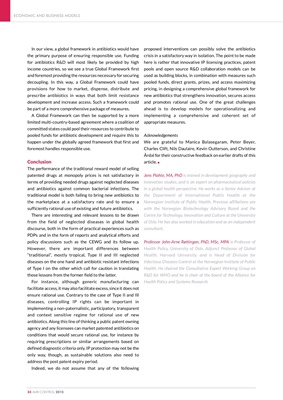
In our view, a global framework in antibiotics would have
the primary purpose of ensuring responsible use. Funding
for antibiotics R&D will most likely be provided by high
income countries, so we see a true Global Framework first
and foremost providing the resources necessary for securing
decoupling. In this way, a Global Framework could have
provisions for how to market, dispense, distribute and
prescribe antibiotics in ways that both limit resistance
development and increase access. Such a framework could
be part of a more comprehensive package of measures.
A Global Framework can then be supported by a more
limited multi-country-based agreement where a coalition of
committed states could pool their resources to contribute to
pooled funds for antibiotic development and require this to
happen under the globally agreed framework that first and
foremost handles responsible use.
Conclusion
The performance of the traditional reward model of selling
patented drugs at monopoly prices is not satisfactory in
terms of providing needed drugs against neglected diseases
and antibiotics against common bacterial infections. The
traditional model is both failing to bring new antibiotics to
the marketplace at a satisfactory rate and to ensure a
sufficiently rational use of existing and future antibiotics.
There are interesting and relevant lessons to be drawn
from the field of neglected diseases in global health
discourse, both in the form of practical experiences such as
PDPs and in the form of reports and analytical efforts and
policy discussions such as the CEWG and its follow up.
However, there are important differences between
"traditional", mostly tropical, Type II and III neglected
diseases on the one hand and antibiotic resistant infections
of Type I on the other which call for caution in translating
those lessons from the former field to the latter.
For instance, although generic manufacturing can
facilitate access, it may also facilitate excess, since it does not
ensure rational use. Contrary to the case of Type II and III
diseases, controlling IP rights can be important in
implementing a non-paternalistic, participatory, transparent
and context sensitive regime for rational use of new
antibiotics. Along this line of thinking a public patent owning
agency and any licensees can market patented antibiotics on
conditions that would secure rational use, for instance by
requiring prescriptions or similar arrangements based on
defined diagnostic criteria only. IP protection may not be the
only way, though, as sustainable solutions also need to
address the post patent expiry period.
Indeed, we do not assume that any of the following
proposed interventions can possibly solve the antibiotics
crisis in a satisfactory way in isolation. The point to be made
here is rather that innovative IP licensing practices, patent
pools and open source R&D collaboration models can be
used as building blocks, in combination with measures such
pooled funds, direct grants, prizes, and access maximizing
pricing, in designing a comprehensive global framework for
new antibiotics that strengthens innovation, secures access
and promotes rational use. One of the great challenges
ahead is to develop models for operationalizing and
implementing a comprehensive and coherent set of
appropriate measures.
Acknowledgements
We are grateful to Manica Balasegaram, Peter Beyer,
Charles Clift, Nils Daulaire, Kevin Outterson, and Christine
Årdal for their constructive feedback on earlier drafts of this
article. l
Jens Plahte, MA, PhD is trained in development geography and
innovation studies, and is an expert on pharmaceutical policies
in a global health perspective. He works as a Senior Advisor at
the Department of International Public Health at the
Norwegian Institute of Public Health. Previous affiliations are
with the Norwegian Biotechnology Advisory Board and the
Centre for Technology, Innovation and Culture at the University
of Oslo. He has also worked in education and as an independent
consultant.
Professor John-Arne Røttingen, PhD, MSc, MPA is Professor of
Health Policy, University of Oslo, Adjunct Professor of Global
Health, Harvard University, and is Head of Division for
Infectious Diseases Control at the Norwegian Institute of Public
Health. He chaired the Consultative Expert Working Group on
R&D for WHO and he is chair of the board of the Alliance for
Health Policy and Systems Research.
ECONOMIC AND BUSINESS MODELS
24 AMR CONTROL 2015